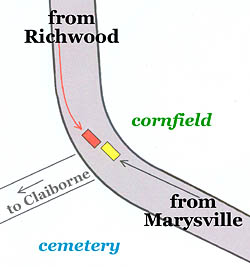Sideswiped!
Written
November 26, 1957
About a year ago we had an automobile accident.
It happened on a Saturday, because I remember I woke up earlier than usual. Mother would have gone to Marysville for parts without me, but I woke up in time to go with her.
On the way back, there is a 90° turn just out of Richwood. This year, there was a cornfield on the inner side of the curve. This cornfield blocked vision around the curve.
|
Then just as we got to the curve a stake truck appeared, coming the other direction. It seems whenever a car or truck comes around a curve, they always move to the center. Therefore, we collided almost head-on. |
|
The truck glanced off, turned around, and went on its side. The door on my side flew open, but I didn't fall out.
If we had hit just slightly different, the wreck could have been much worse. But we were only slightly injured, the truck driver not at all.
|
Background: I wrote this essay for my fifth-grade English class. It's the earliest non-childish composition of mine that I've discovered in the archives.
I made the drawing below in 2003.
The tall corn, awaiting the harvest, had hidden our car and the truck from each other as we approached the banked curve at 50 miles per hour. If the two drivers had been aware of the oncoming traffic, both would have been more careful to stay on their respective sides of the centerline. And if cars had been equipped with seatbelts back then, we wouldn't have sustained a scratch. As it was, my only injury was a knee laceration. We were lucky. For several summers afterward, we noticed that the field on the inside of the corner was no longer a cornfield. Instead, the farmer planted lower-lying crops like alfalfa or soybeans. |


 The collision, in which the left front wheel of the truck smashed
into our car's left front fender, took place a couple of miles south
of Richwood on Ohio Route 37, probably in October 1956.
The collision, in which the left front wheel of the truck smashed
into our car's left front fender, took place a couple of miles south
of Richwood on Ohio Route 37, probably in October 1956.